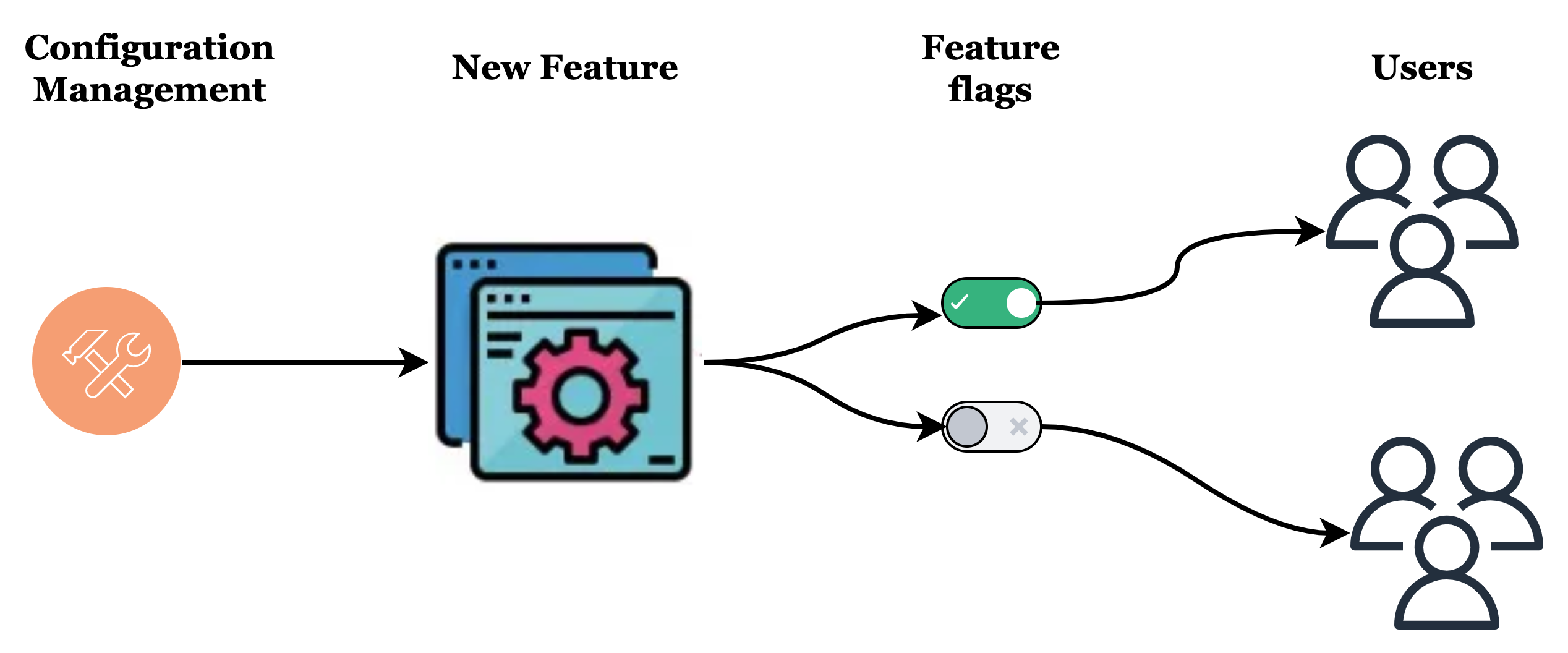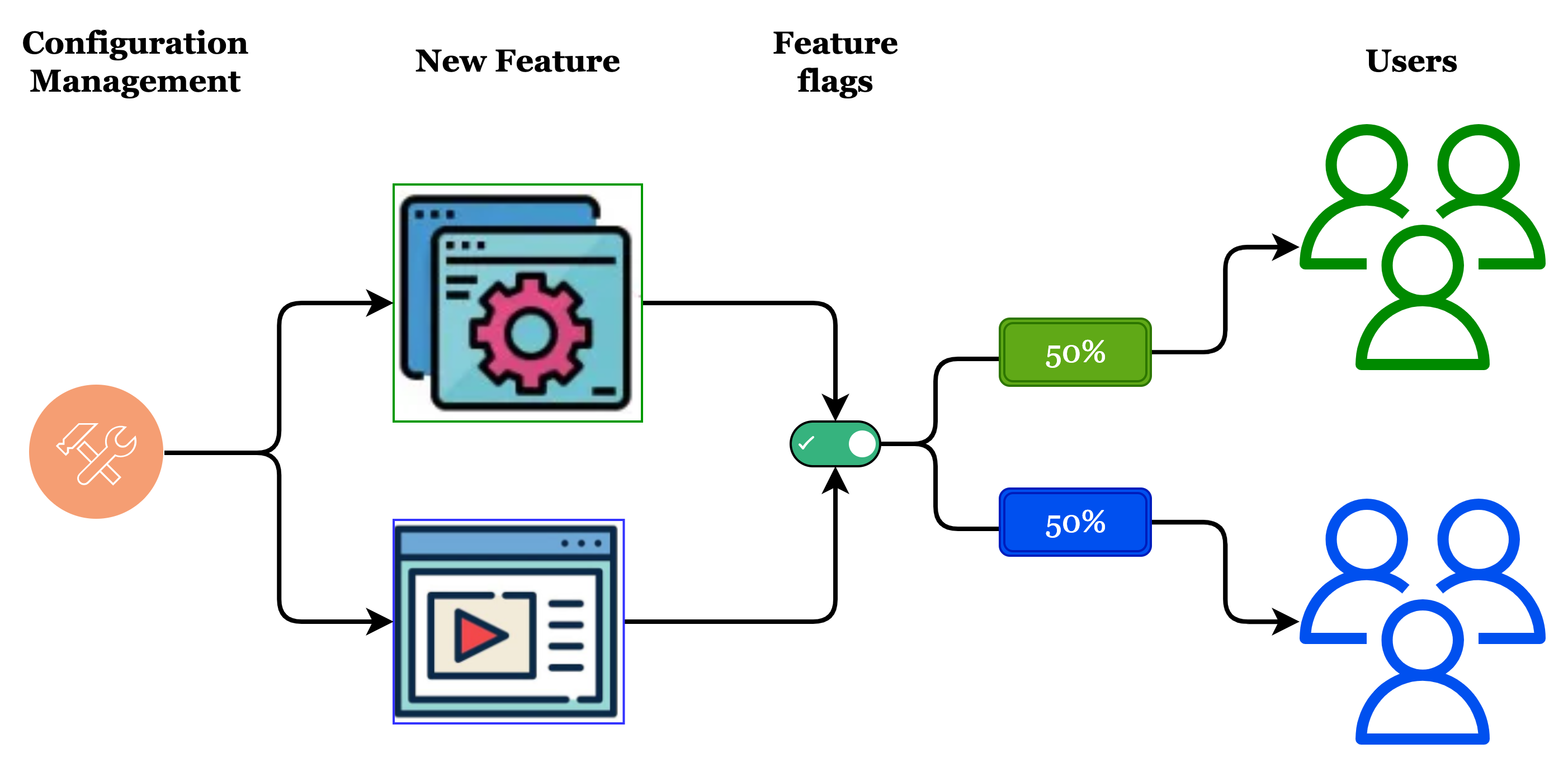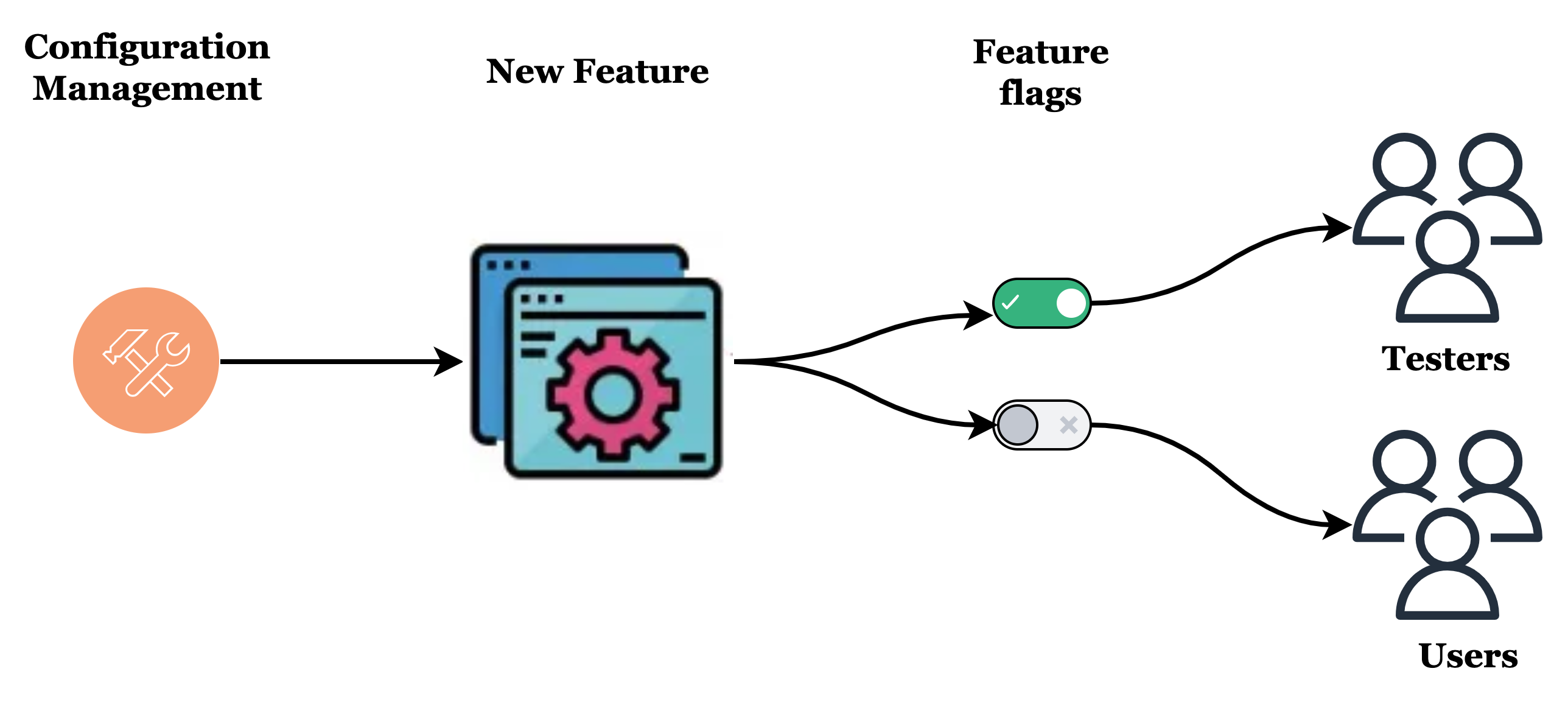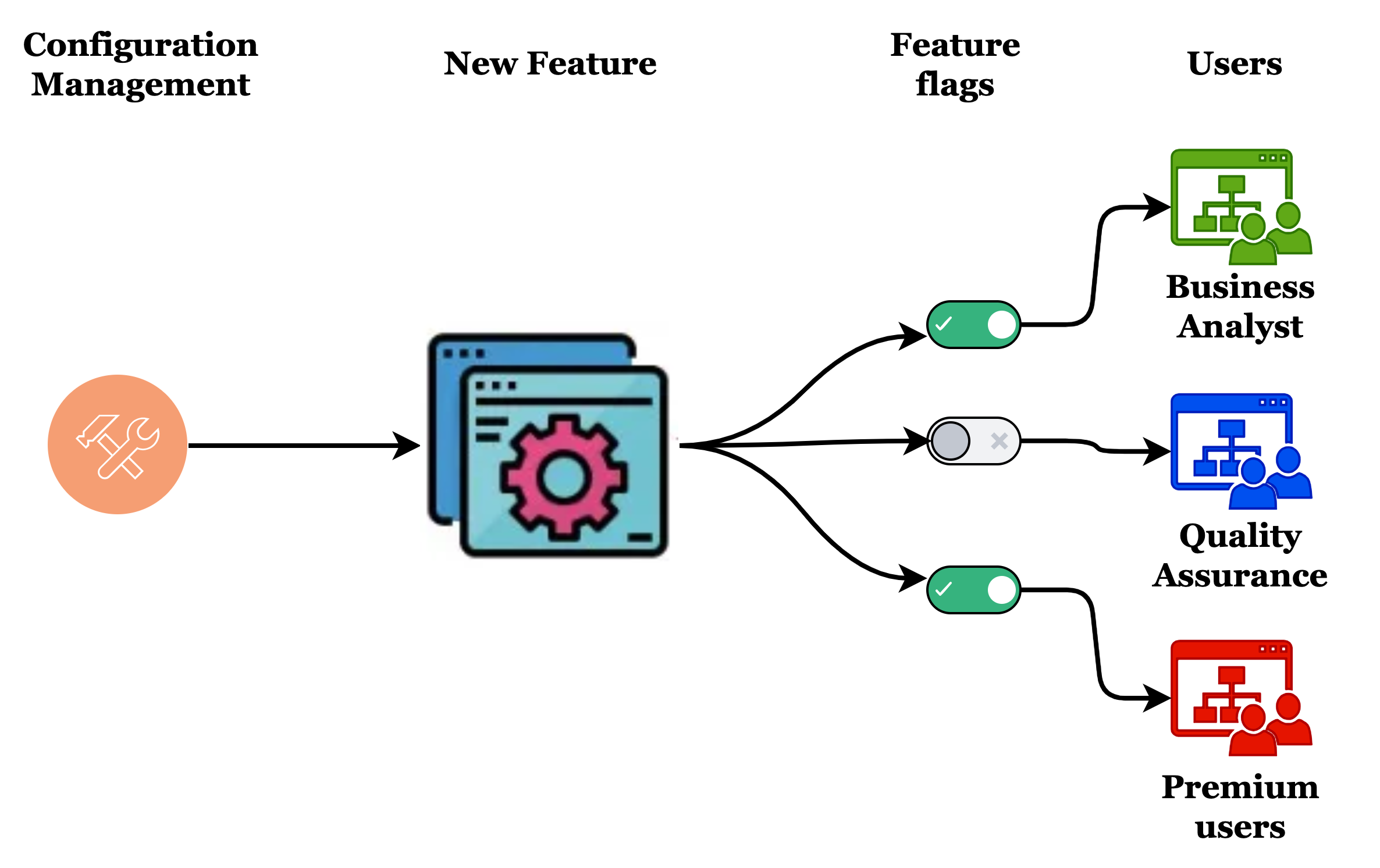Advanced Deployment Strategies
Advanced deployment strategies leverage feature flags and centralized configuration management to improve software delivery.
Join the DZone community and get the full member experience.
Join For FreeIn today's software development and deployment, maintaining agility, stability, and security is crucial. Centralized configuration management and feature flags are tools that help in achieving these goals. Integrating these into an organization’s DevSecOps process provides the flexibility needed to respond to changes quickly and effectively.
Feature Flag Driven Development (FFDD)
Feature Flag Driven Development (FFDD) is a software development approach that uses feature flags or toggles. These flags help to control the new feature deployments. The main goal of FFDD is to separate the development and release of new features. This provides flexibility to development teams and allows them to roll out features gradually and choose specific user groups to test them.
Key Principles of FFDD
- FFDD provides control of feature visibility at the individual user level. This control enables the possibility of targeted testing and a gradual rollout of new features with more controlled deployment.
- With FFDD, teams can continuously deploy code to production without revealing the new features to end users. This approach allows flexible deployments with faster feedback loops.
- FFDD allows teams to quickly turn off the released features, in case of issues or negative user feedback. This reduces the risk associated with deploying un-tested/unstable new features. FFDD provides a faster way to bring back the applications to their previous working state.
- FFDD allows incremental rollout of new features, by releasing the features to a smaller percentage of users. Based on the performance and feedback gathered, the feature can be gradually rolled out to all users.
- With FFDD, features can be released to a subset of users to gather feedback. This allows teams to make decisions about the improvements to be made to the feature.
Benefits of FFDD
- FFDD separates development and deployment, allowing teams to roll out features more quickly.
- By testing features directly in production, teams can identify and resolve issues, ensuring high-quality software and faster releases.
- Quickly toggling off features minimizes the need for rollbacks and re-deployments. This reduces the downtime and negative impact on users.
- FFDD improves the collaboration between development, QA, and product teams, helping everyone gain a better understanding of feature requirements.
- Feature flags provide the flexibility to adjust features at runtime without needing code changes or redeployment.
Centralized Configuration Management (CCM)
Centralized configuration management (CCM) is a practice that involves managing configuration settings for applications from a central location. Here are the key principles and benefits of CCM:
Key Principles
- CCM ensures that all application instances use the same configuration settings by acting as a single source of truth.
- CCM includes version control (GitOps), and this helps developers to track changes to configurations easily.
- CCM guarantees consistent configurations across all environments, significantly reducing the risk of errors.
- CCM automates the management of configurations, minimizing manual effort and reducing the risk of human error.
Benefits
- CCM improves the deployment process by providing centralized management, reducing human errors, and ensuring consistency.
- CCM allows quicker deployments, reducing the time to market.
- With centralized configurations, maintenance becomes easier and more efficient.
- CCM makes the collaboration between development, operations, and QA teams easier, by offering a centralized location for managing configurations, ensuring consistency across teams.
- CCM often includes features for change management and tracking, ensuring compliance with regulatory requirements like GDPR or PCI DSS.
- By reducing the manual effort needed to manage configurations, CCM results in significant cost savings.
Advanced Deployment Strategies
Rolling Updates

FFDD and CCM play a major role in enabling rolling updates, by providing control and flexibility to the deployment process.
With FFDD, teams can roll out changes gradually. This allows monitoring of performance and user feedback before the team performs a full rollout.
CCM ensures that the configurations are consistent across various environments, and makes it easier to control the deployments.
The combination of FFDD and CCM enables teams to deploy updates in a safer and more effective way. It reduces the risk of manual errors and downtimes. It also speeds up the debugging process when errors are faced by the users, as the configuration is centralized.
Case Study
Here is a hypothetical case study on how rolling updates with feature flags and centralized configuration management can be implemented:
- Scenario: An e-commerce platform is planning to release a new feature that allows users to save items to their wish list directly from the product listing page. The development team wants to roll out this feature gradually to their users.
- Implementation: The team uses feature flags to enable the new wish-list feature for a small percentage of users. They also utilize centralized configuration management to manage the configuration settings such as the button's appearance and behaviour.
- Rollout strategy: The team starts with a 5% rollout and monitors the performance of the feature. After gathering the user feedback they gradually increase the rollout percentage until it's rolled to all users. The team monitors the user feedback at every stage of the rollout.
- Benefits: By using feature flags and centralized configuration management, the team can roll out the new feature in a controlled way, identify and address any issues, and are able to deliver a better experience to users.
Canary Releases

FFDD and CCM facilitate canary releases by providing controlled, flexible, and consistent deployments.
FFDD allows teams to gradually release new features to a small subset of users. This provides control to the teams to identify any issues or bugs early on, reducing the impact of the issues on the entire user base.
CCM ensures that the configurations are centrally managed, making it easier to roll out the changes faster and easier. This also ensures consistency across environments.
This combination enables teams to deploy the canaries efficiently, and mitigate the risks associated with new releases early, with feedback from the subset of users.
Case Study
Here is a hypothetical case study on how canary release with feature flags and centralized configuration management can be implemented:
- Scenario: A social media platform wants to introduce a new algorithm that displays the posts in users’ feeds. The platform wants to make sure that the new algorithm improves user engagement.
- Implementation: The development team uses feature flags to enable the new algorithm for a subset of users, while the rest of the users continue with the existing algorithm. The team also uses centralized configuration management to manage new configuration settings applicable to the new algorithm, such as the weightage of different factors that decide the post visibility.
- Rollout strategy: The team monitors the user engagement, post visibility metrics, and user feedback, if any. Based on these, the team decided to increase the percentage of users who see the posts based on the new algorithm.
- Benefits: By using feature flags and centralized configuration management, the team can test the new algorithm with a subset of users, before rolling out the new algorithm to all users. This helps minimize the risk of negative user impact and helps in a smooth transition to the new algorithm.
A/B Testing

FFDD and CCM play a key role in conducting A/B testing and help control the experiments efficiently.
FFDD allows teams to easily enable or disable different versions of a feature for various user groups. Performance and feedback results of the A/B tests can be compared for different implementations.
CCM makes sure that the configuration for the A/B testing environments is managed centrally, so that it’s easier to adjust the test parameters, if any.
Together, FFDD and CCM enable teams to conduct A/B tests with precision and to gather feedback. This helps the teams to make data-driven decisions to improve their products/services.
Case Study
Here is a hypothetical case study on how A/B testing can be implemented with feature flags and centralized configuration management:
- Scenario: A news website’s mobile app is testing two different headline styles to see which one attracts more readers to their site. The team wants to test the impact of headline style on user engagement.
- Implementation: The team uses feature flags to create two variations of headline styles: Style A & Style B. They also use centralized configuration management to manage the configuration settings for each headline style, such as font size, color, and placement.
- A/B Testing Strategy: The team displays the headlines in either style A or style B to users. The team tracks the click-through rates, and other metrics like time spent on the article, and social shares for each headline style. Based on this data, the impact of each headline style is measured and the final style to be rolled out is decided.
- Benefits: By using feature flags and centralized configuration management, the team can easily test different headline styles and gather data on user engagement. This helps the team to make informed decisions to use in the future.
Dark Launch

FFDD and CCM can help Dark Launching new features by providing a controlled environment to test in production without exposing them to end users.
FFDD allows teams to deploy new features which can be toggled on or off at runtime only to the testers.
CCM controls the configurations for the Dark Launch environment centrally, making it easier to do the feature rollout.
This approach allows teams to test the new features in the production-like setting, and address any issues before fully releasing the feature to all users.
Case Study
Here is a hypothetical case study on how Dark Launch with feature flags and centralized configuration management can be implemented:
- Scenario: A financial services platform is developing a new feature that allows users to apply for loans online. The platform wants to test this feature in production without exposing it to the end users until it is fully tested.
- Implementation: The development team uses feature flags to enable the loan application feature for internal testing only. They also use centralized configuration management to manage the configuration settings for the feature like the approval process.
- Dark Launch Strategy: The team tests the loan application feature internally in production. Once it is fully tested and approved, they enable it for external users.
- Benefits: By using feature flags and centralized configuration management, the team can test the loan application feature in a production-like environment, and minimize the risk of exposing users to an unstable feature.
User Segmentation

FFDD and CCM enable the delivery of personalized experiences to different user groups based on specific criteria.
FFDD allows teams to enable or disable features for different segments of users and ensures that each group receives a personalized experience.
CCM ensures that the configurations for each user segment are managed centrally.
FFDD and CCM enable teams to deliver personalized experiences based on user behavior and preferences.
Case Study
Here is a hypothetical case study on how User Segmentation with feature flags and centralized configuration management can be implemented:
- Scenario: A streaming platform plans to introduce a new subscription plan, with exclusive content to their users. The platform wants to test the new plan with a select group of users before making it available to all users.
- Implementation: The development team uses feature flags to enable the new premium plan for a smaller group of users who meet the specific criteria. They also use centralized configuration management to manage the configuration settings for the new plan, such as pricing and content availability.
- User segmentation strategy: The team monitors user engagement and determines the effectiveness of the new plan. Based on the metrics gathered, they roll out the plan to a wider audience.
- Benefits: By using feature flags and centralized configuration management, the team can test the new premium plan with a select group of users. Based on the feedback, the feature is rolled out to all users. This approach helps to understand the user expectations and thereby increases the revenue.
Tools for Implementing FFDD and CCM
Centralized Configuration Management
- IBM cloud app configuration helps in centralized configuration management by providing a centralized, unified platform to store, manage, and deploy application configurations across different environments. It offers centralized configuration settings and environment-specific parameters including secrets. This also supports exporting the configurations to a version-controlled repository like Git.
- Azure app configuration helps centrally manage application settings and feature flags, enabling seamless updates and configurations across distributed applications.
- HashiCorp consul is a service mesh networking solution that provides service discovery, configuration, and segmentation capabilities. It allows centralized configuration storage and distribution of the configuration to your services.
- Spring cloud config provides server and client-side support for externalized configuration in a distributed system. It allows you to store configuration data in a version-controlled repository (e.g. Git) and distribute it to your applications.
- AWS systems manager parameter store provides secure, hierarchical storage for configuration data and secrets management. It integrates seamlessly with other AWS services and provides versioning and encryption capabilities.
- Etcd is a distributed key-value store that is often used for service discovery and configuration management in Kubernetes clusters. It provides a reliable, distributed data store for storing configuration data.
Feature Flags
- IBM cloud app configuration helps in feature flag management to create, manage, and deploy feature flags in your applications. With IBM Cloud App Configuration, you can easily create feature flags to control the rollout of new features and experiment with different variations. It allows you to define different segments of users and target specific groups with different feature flag configurations, enabling you to perform A/B testing and measure the impact of changes based on user behavior.
- LaunchDarkly is a feature management platform that allows you to control feature lifecycles, target specific user segments, and perform A/B testing. It provides SDKs for various programming languages and integrations with popular development tools.
- Split.io is a feature flagging and experimentation platform that allows you to roll out features gradually, target specific user segments, and measure the impact of changes on key metrics. It provides SDKs for multiple languages and integrations with CI/CD pipelines.
- Flagsmith is an open-source feature flagging and experimentation platform that allows you to manage feature flags, remote configurations, and user segmentation. It provides a user-friendly dashboard and SDKs for multiple languages.
- Optimizely is an experimentation platform that allows you to run A/B tests, multivariate tests, and personalization campaigns. It provides a visual editor for creating experiments and integrations with popular analytics tools.
- Rollout.io is a feature flagging and experimentation platform that allows you to control feature releases, target specific user segments, and monitor feature performance in real time. It provides SDKs for various platforms and languages.
Conclusion
Advanced deployment strategies like Centralized Configuration Management and Feature Flags provide significant benefits and controls for deployment. By implementing these strategies organizations can achieve flexibility, agility, and control over their deployments.
Opinions expressed by DZone contributors are their own.

Comments